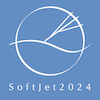Speaker
Description
We begin by using Hybrid Model calculations to reproduce experimental results published by ATLAS in 2023 on $R_{AA}$ for $R=1$ jets in Pb+Pb collisions. These jets are identified via first reconstructing anti-$k_t$ $R=0.2$ subjets and then reclustering them. Following ATLAS, we investigate how $R_{AA}$ for these large-radius jets depends on the angle between the two subjets involved in the final clustering step of the $R=1$ jet. We also study the dependence of $R_{AA}$ for these jets on the resolution length of QGP, which suggests that measurements like those pioneered by ATLAS can constrain this property of QGP.
We also use this setup to analyze the response of the medium to the passage of large-radius $R=2$ jets containing two $R=0.2$ subjets, produced in gamma-jet events, and identified as above. We introduce novel jet-shape observables that allow us to visualize the angular shape of the soft hadrons originating from wakes that wide jets with two skinny subjets excite in the droplet of QGP, as a function of the angular separation between the subjets. We find that even when two hard subjets are 0.8 to 1.0 radians apart, a single broad wake is produced. When the two subjets are even farther apart, the presence of two sub-wakes is revealed. We show that the way in which the structure of hard jets shapes their soft wakes can be visualized with similar clarity in experiments by measuring the observables we have introduced using only soft hadrons with low transverse momenta.
| Category | Theory |
|---|
